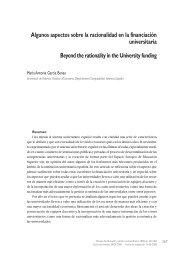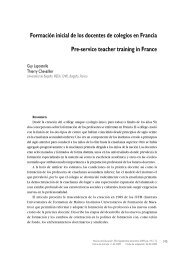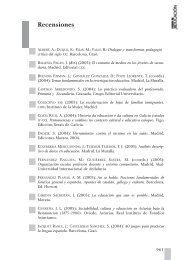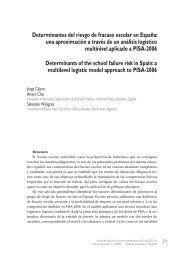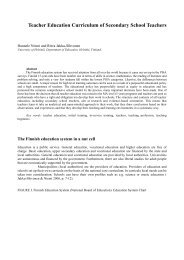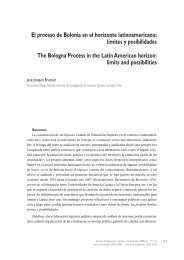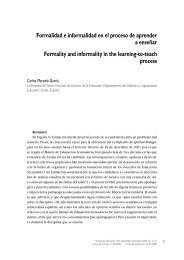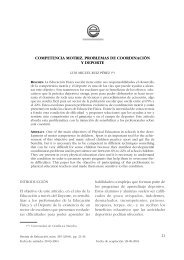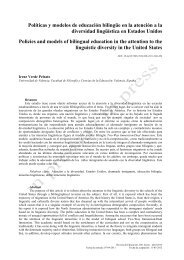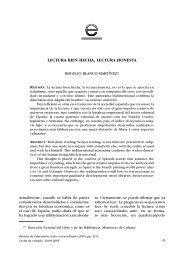Social and work integration projects in Spain and Germany from the ...
Social and work integration projects in Spain and Germany from the ...
Social and work integration projects in Spain and Germany from the ...
You also want an ePaper? Increase the reach of your titles
YUMPU automatically turns print PDFs into web optimized ePapers that Google loves.
This support is part of <strong>the</strong> structured offer tak<strong>in</strong>g <strong>the</strong> form of programmes, staff, organisation <strong>and</strong>situation.It is a support that must subjectively be experienced as such by young people <strong>and</strong> that needs to betailored to <strong>the</strong> <strong>in</strong>dividual situation. O<strong>the</strong>rwise, <strong>the</strong> young people – if <strong>the</strong>y take part voluntarily en losproyectos de <strong>in</strong>serción socio-laboral – will soon drop out of <strong>the</strong> social <strong>work</strong> programmes. Subjectivelyexperienced support is <strong>the</strong> means for perceiv<strong>in</strong>g <strong>the</strong> use of <strong>and</strong> <strong>the</strong> <strong>in</strong>dividual fit with social <strong>work</strong>.Individual fit is generated by subjectively experienced support. Accord<strong>in</strong>g to Hanses (2003),<strong>in</strong>dividual agency <strong>and</strong> biographical resources are often not taken <strong>in</strong>to account with<strong>in</strong> <strong>the</strong> frame<strong>work</strong> ofprofessional socio-pedagogical contexts. Then, due to <strong>the</strong> «socio-pedagogical disregard» of <strong>the</strong><strong>in</strong>dividual biographical dimension, <strong>in</strong>dividuals would not accept any necessary support programmesavailable. What k<strong>in</strong>d of activity <strong>and</strong> design is needed for social <strong>work</strong> <strong>in</strong> social <strong>and</strong> <strong>work</strong> <strong><strong>in</strong>tegration</strong><strong>projects</strong> so that <strong>in</strong>dividuals can <strong>in</strong>tegrate it <strong>in</strong>to <strong>the</strong>ir biography as an <strong>in</strong>dividually fitt<strong>in</strong>g part? In thiscontext, <strong>the</strong> concept of fit is not used <strong>in</strong> a normative sense, but ra<strong>the</strong>r understood as acceptance <strong>and</strong><strong><strong>in</strong>tegration</strong> of social <strong>work</strong> <strong>in</strong>to one's own biography. Consequently, <strong>the</strong> key research question is: Howdo young women <strong>in</strong> Spa<strong>in</strong> <strong>and</strong> <strong>Germany</strong> develop <strong>the</strong> <strong>in</strong>dividual fit between socio-pedagogicalqualification <strong>and</strong> employment schemes <strong>and</strong> <strong>the</strong>ir own biography?Methodological basisTrac<strong>in</strong>g <strong>and</strong> <strong>work</strong><strong>in</strong>g out <strong>the</strong> <strong>in</strong>dividual fit, acceptance <strong>and</strong> <strong><strong>in</strong>tegration</strong> of <strong>the</strong> socio-pedagogicalqualification <strong>and</strong> employment schemes <strong>in</strong> <strong>the</strong> young women’s biographies requires <strong>the</strong> reconstructionof <strong>the</strong>ir biographies. The narrative <strong>in</strong>terview developed by Fritz Schütze (1981, 1983, 1984, 1987)seemed to be an appropriate methodical approach to reconstruct biographies. In most cases, <strong>the</strong>objective of a narrative <strong>in</strong>terview is to ga<strong>in</strong> additional <strong>in</strong>formation about <strong>the</strong> <strong>in</strong>terviewee that cannot beobta<strong>in</strong>ed by st<strong>and</strong>ardised surveys or tests, like, for <strong>in</strong>stance, <strong>the</strong> question regard<strong>in</strong>g subjectivelyexperienced support. The method allows very specific <strong>and</strong> <strong>in</strong>dividual problems of <strong>the</strong> <strong>in</strong>terviewee tobe revealed.The research process <strong>and</strong> <strong>the</strong> research designThe research question refers to <strong>the</strong> <strong>in</strong>dividual fit of young women participat<strong>in</strong>g <strong>in</strong> qualificationschemes for <strong>the</strong> <strong><strong>in</strong>tegration</strong> <strong>in</strong>to <strong>the</strong> first labour market, i. e. who are <strong>in</strong> transition – «<strong>in</strong>to <strong>the</strong> society».Therefore, only those <strong>projects</strong> were selected whose project aim is to support young women <strong>in</strong> <strong>the</strong>ir<strong><strong>in</strong>tegration</strong> process <strong>and</strong> <strong>in</strong> manag<strong>in</strong>g <strong>the</strong> transition accompanied by socio-pedagogical support.Participation <strong>in</strong> <strong>the</strong> project should be preceded by <strong>the</strong> existence of exclusion criteria represent<strong>in</strong>gobstacles to successful job seek<strong>in</strong>g such as «(female) youth unemployment», «school absenteeism», or«young <strong>and</strong> s<strong>in</strong>gle parent» (cf. Paul-Kohlhoff/Paul/Zybell, 2001) <strong>and</strong> that are similarly def<strong>in</strong>edthroughout European societies. These should be <strong>the</strong> admission criteria for participat<strong>in</strong>g <strong>in</strong> <strong>the</strong> scheme.The criteria were selected on <strong>the</strong> basis of tendencies described as primary exclusion reasons <strong>in</strong> bothcountries.For <strong>Germany</strong>, «young <strong>and</strong> s<strong>in</strong>gle parent» was selected as an exclusion criterion. With youngs<strong>in</strong>gle parents <strong>the</strong> cumulation of <strong>the</strong> different discrim<strong>in</strong>ations <strong>in</strong> <strong>the</strong> transition phase becomesespecially apparent. In <strong>Germany</strong>, <strong>the</strong> poverty rate of s<strong>in</strong>gle parents is relatively high compared to o<strong>the</strong>rEuropean countries. «Young <strong>and</strong> s<strong>in</strong>gle parent» means <strong>the</strong> divergence <strong>in</strong> many ways <strong>from</strong> established<strong>in</strong>stitutionalized schedule models, <strong>from</strong> successive phases of qualification <strong>and</strong> transition that po<strong>in</strong>t <strong>the</strong>way ahead. Examples are miss<strong>in</strong>g school leav<strong>in</strong>g certificates or low education, dropouts <strong>from</strong>vocational tra<strong>in</strong><strong>in</strong>g <strong>and</strong> precarious job situation (for figures, cf. Hovestadt, 2003). Compared to <strong>the</strong>ircohorts, young mo<strong>the</strong>rs have to make <strong>the</strong>ir liv<strong>in</strong>g assisted by transfer payments of <strong>the</strong> welfare statemore often than average (cf. Nader, Paul, Paul-Kohlhoff, 2003, 17 ff., 30 ff.; Hammer, 2003; Lex,1997, 260 f.; Zybell, 2003, 55 ff., Geissler, Oechsle, 1994).School absenteeism, <strong>in</strong>clud<strong>in</strong>g academic failure, early school leav<strong>in</strong>g <strong>and</strong> truancy, <strong>in</strong> general«difficulties <strong>in</strong> achiev<strong>in</strong>g objectives set by <strong>the</strong> educational system» (Navarrete Moreno, 2007b, p. 5),was selected as <strong>the</strong> criterion for Spa<strong>in</strong>. It is obvious that for <strong>the</strong> <strong><strong>in</strong>tegration</strong> <strong>in</strong>to <strong>the</strong> first labour markethav<strong>in</strong>g no school leav<strong>in</strong>g certificate or only low education is a disadvantage. The consequence is



